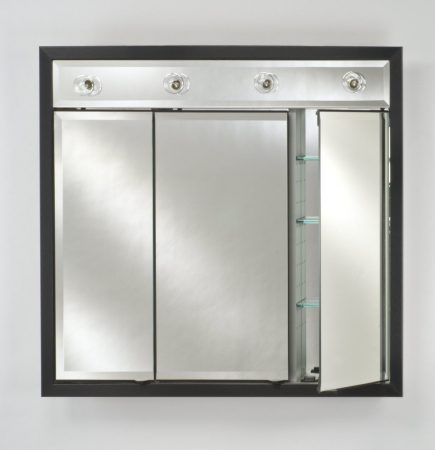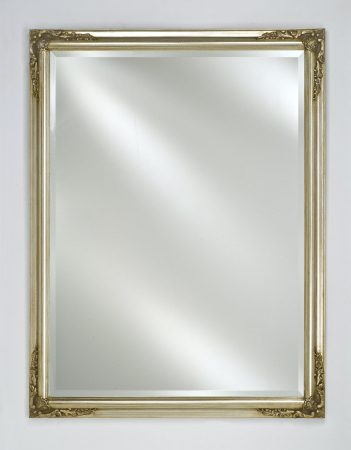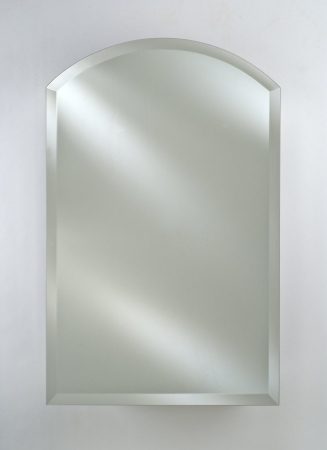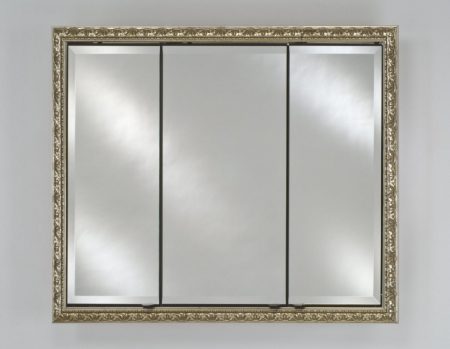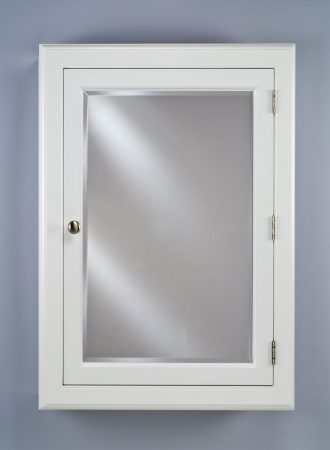Medicine cabinets have been around for a long time. Although they’ve been replaced with different types of vanity cabinets and mirrors over the years, many people still use them, still love them, and have been waiting for this day. That’s because now, medicine cabinets are making a comeback. As more designs focus on function along with form, and more people choose retro styles like rustic farmhouse and mid-century modern, this functional fixture is getting a lot more publicity.
To help you decide if medicine cabinets are right for your space, here are 10 questions and their answers.
Related: Do New Bathrooms Use Medicine Cabinets? YES! Take A Look
Signature Collection Custom Framed Triple Door Medicine Cabinet with Contemporary Integral Lighting
- Are Medicine Cabinets in Style Now?
- How Do You Measure a Medicine Cabinet?
- What Is a Good Height for a Medicine Cabinet?
- What Is the Difference Between Surface and Recessed Mount?
- Can Medicine Cabinets Be Wider than the Vanity?
- Why Is the Bathroom Medicine Cabinet Not Always the Best Place to Store Medicine?
- What Should You Store in a Medicine Cabinet?
- What Are the Benefits of Medicine Cabinets?
- What Are Some Modern Features of Medicine Cabinets?
- Should I Get a Recessed or Wall-Mounted Medicine Cabinet?
- Conclusion
Are Medicine Cabinets in Style Now?
Medicine cabinets never really went out of style, per se. It was more that mirrored cabinets and bathroom vanities with standard mirrors took the lead in many designs, which led a lot of people to forget about the longstanding, reliable medicine cabinet. As mentioned above, thanks to modern design trends and the increased need for function, these cabinets are making a comeback, of sorts.
How Do You Measure a Medicine Cabinet?
To measure a medicine cabinet, you’ll want to measure the dimensions of the cabinet itself (length x width), as well as the door or mirror that it has (if those dimensions are different). With recessed cabinets, you’ll need to measure the depth to ensure they are installed flush with the wall. Surface mount cabinets require less measuring and are often easier to install. However, you’ll still want to make sure that you have enough space for it on the wall.
Basix Plus Single Door Medicine Cabinet
What Is a Good Height for a Medicine Cabinet?
Some people use the rule of thumb that the top of the cabinet should be 72 inches from the floor. However, if you hang it too high, you won’t be able to use the mirror properly. If you need to install it lower, go ahead. Most people make the mistake of installing a medicine cabinet too high rather than too low, so always err on the side of caution. You can even hold it up before choosing a height to see where it fits best.
Related: Should You Choose A Medicine Cabinet Or A Vanity With Lots Of Storage?
What Is the Difference Between Surface and Recessed Mount?
A surface-mount medicine cabinet is installed on the wall, usually using anchor screws to ensure that it holds the weight necessary. A recessed mount cabinet is inset in the wall—if there is not an existing hole for one in the bathroom, it will have to be made before installation. This allows the cabinet to sit flush with the wall instead of jutting out like a wall-mount cabinet does.
Arched Single Door Medicine Cabinet
Can Medicine Cabinets Be Wider than the Vanity?
Medicine cabinets and vanity mirrors can be any size that you like. Mixing and matching sizes, when you also choose the right fixtures and designs, can create a unique look. Usually, medicine cabinets are narrower than the vanity, but they come in all sizes. Choosing an oversized cabinet or mirror could add a dramatic touch to the space and help the floor space seem larger in some ways, too.
Related: 6 Questions About Bathroom Mirrors
Why Is the Bathroom Medicine Cabinet Not Always the Best Place to Store Medicine?
There are several reasons not to store medicine in the bathroom medicine cabinet. For starters, the bathroom is damp and humid, and often warm—most medicine requires being stored in a cool, dry place. Not only that, but medicine cabinets aren’t secure. Children, guests, and others can have access to various medications, including prescriptions and dangerous drugs, and that can present a safety risk. Medicines are best kept in locked cabinets when they are dangerous or children are around and in less humid rooms, such as the bedroom or even a hall closet.
Signature Collection Custom Framed Triple Door Medicine Cabinet
What Should You Store in a Medicine Cabinet?
For starters, your toothbrushes should go in here. A lot of people leave them on the sink or counter, but this leaves the bristles susceptible to whatever gross things go airborne during regular bathroom use. Other items to store in your medicine cabinet include first aid items, a thermometer, tweezers, nail clippers, and unopened items. You don’t want to store beauty or personal care products here because they will be susceptible to the humidity. Razors can also be rusted by the humidity, so it’s best to store those elsewhere, too.
Related: Decluttering Your Bathroom Is The Key To Redecorating
What Are the Benefits of Medicine Cabinets?
Medicine cabinets come with several benefits. Namely, they provide more storage and function in the space than just installing a mirror. They give you space to store toiletries and medications (although you might want to be careful with the latter—more on that in a bit). They come in several design options to fit any bathroom style and they can increase the aesthetics of any space, all while offering functional use.
Three Mirrored Door Medicine Cabinet
What Are Some Modern Features of Medicine Cabinets?
Modern medicine cabinets have unique features like differently-shaped mirrors (such as an oval mirror over a rectangular cabinet. Some include multiple doors to give you dual- or tri-view mirrors so that you can get ready and ensure that you look your best. They also feature premium modern materials and styles that blend into any design. Plus, they’re available in just about any size and mounting option needed.
Related: How To Get The Most Space From A Small Bathroom
Should I Get a Recessed or Wall-Mounted Medicine Cabinet?
Recessed medicine cabinets save space in small bathrooms because they are set into the wall. However, unless you already have one in place, you’ll have to cut a hole in the wall and make sure that you create the appropriate recess, which can take more work and cost more money. Wall-mounted models stick out a few inches, but they are easier to install and require less of an investment, in many cases.
Devon Single Door Medicine Cabinet
Conclusion
Now that you know more about medicine cabinets and what they have to offer, you can decide whether or not they’re the right fit for your space. Let your creative inspiration drive you, and remember that despite the name, medicines might not always be the best to store in these cabinets. Find your perfect fit now.

